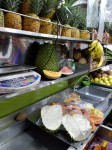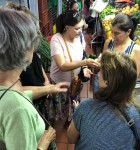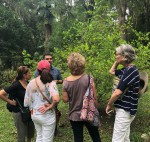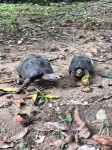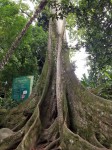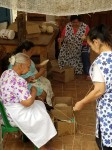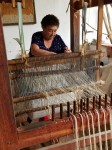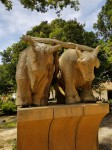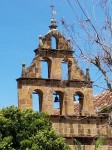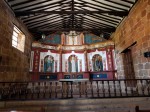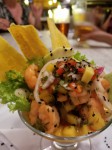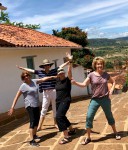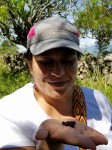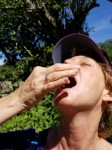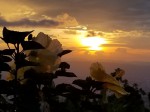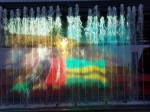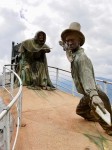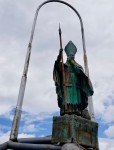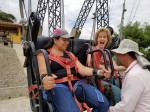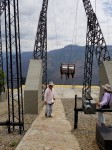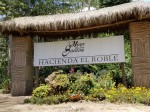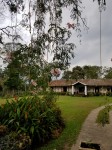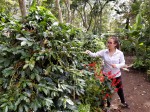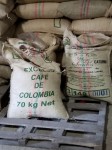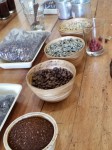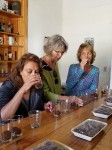At the beginning of a new Spanish class at Santa Fe Community College, I introduced myself to Pam, the lady sitting next to me. We chatted briefly. At the next class, she told me about Vamonos de Fiesta!, a two-week Spanish immersion program to be held in Bucaramanga, Colombia in July and taught by Naly Ramirez (naly.ramirez@gmail.com). I was hooked on improving my Spanish and determined to be one of four ladies to make the trip.
On July 6, 2018, the 4 Mujeres met at the ABQ airport to begin our journey to Bucaramanga, Colombia and two weeks Spanish immersion.
After a long flight, Naly Ramirez greeted us at the airport. Some well needed rest was first on the agenda until classes began the next morning. Each morning, we gathered around a table in our apartment to learn a designated aspect of the Spanish language, such as the imperfect tense, the conditional, and commands, just to mention a few topics we covered. But, the emphasis was on speaking, not grammar. After class, Naly would introduce us to points of interest in the community where we could practice speaking and listen to spoken Spanish.
Learning about Colombian food, the market, and botanical garden:
Bright and early Monday morning, we went to the market for a Colombian breakfast and to select fruit to bring back to our apartment. Colombia has the most varieties of fruit in the world. Our mission was to learn about and taste those fruits. We practiced conversing with the vendors who were very patient with our struggling Spanish.
- Guanabana: popular for making “smoothies” using milk and sugar. Delicious. One of our favorite fruit drinks.
- Breakfast consisted of broth topped with a soft boiled egg and an arepa (much like cornbread in the US).
- Pam and Tan look on while Annie tries to count the correct Colombian pesos to pay for the fruit at the market.
The Jardin Botanico Eloy Valenzuela (Botanical Garden) is located in the metropolitan area of Bucaramanga. Jorge, our guide, explained the importance and uses of the indigenous trees and plants in the garden.
- Intently listening to our guide, Jorge, at the Jardin Botanico Eloy Valenzuela.
- More than 200 tortugas live in the botanical garden.
- Ancient Higueron or Ficus Monckii
The garden was established in 1982 by an initiative of Luis Arango Restrepo to further research and conservation of the trees and plants native to the Santander (state) of Colombia. There are over 200 tortugas living in the garden.
Barichara, a small village approximately 35 miles from Bucaramanga
One of the highlights of our trip was a three day visit to the village of Barichara. The drive was on a windy road into the Andes mountains. We arrived to a beautiful B&B. We were excited to walk around the town and spot restaurants and shops where we would give more attention to the following day.

A view of the town of Barichara from the balcony of our B and B. The cathedral is in the background.
Casa de Don Aquileo and Hogar Centro Dia
Don Aquileo was the only Santandereano ( the state is called Santander) president from this town. He was born in a small casita which is preserved from that time. The most interesting part of this area is the Hogar Centro Dia, where older members of the community gather to make “yarn” from plants and weave bags. The camaraderie and friendliness of the group was inspiring.
- The older women of the community gather at the Hogar Centro Dia.
- One of the ladies at the handicraft shop. She is so beautiful and has a wonderful smile.
- Weaving the yarn into material to make bags.
Capilla de San Antonio
- The beauty of this chapel resides in its simplicity.
- The alter at Capilla de San Antonio.
In 1823, Don Narciso Reyes provided the funds to build this chapel, located across from the park and next to Ancianato. San (Saint) Antonio is the patron saint of Barichara.
Funcacion San Lorenzo de Barichara (Taller de Papel -paper making)
Our guide showed us through the paper making process from the plants used as the basis of the paper to the finished product.
- The plant fiber
- The screen to drain the water from the fiber. Photo by Naly Ramirez.
- Pam, Tan, and Naly looking at the finished paper products.
The San Lorenzo Foundation is the work of Doctor Belisario y Dalita to fabricate special papers from leaves of plants. Much of the paper is used for cup holders at Juan Valdes stores.
Cooking class with Monica Zarate:
Before we were ready to learn Colombian cooking from Monica Zarate, first, we had to learn “cooking” words. After all, you can’t cook if you don’t know the words. Our words included: mezclar – to mix, picar – to cut or dice (we did a lot of this), amasar – to knead, which Monica did when she taught us to make arepas. And, of course, medir – to measure. We had a wonderful time and enjoyed eating our creations of Salpicone and arepas stuffed with chicken.
- Tan dicing the watermelon.
- Monica Zarate, our cooking teacher showing all the fruits that go into the Salpicone.
- Pam preparing to taste the Salpicone we helped to make.
Cementerio
During Holy Week, the resurrection of the Lord is celebrated with a dusting of the bells and general happiness of the people.
Capilla de Santa Barbara and Parque de las Aguas
This chapel of Santa Barbara, built in the 17th century, is located above the town and is built out of rock. Now, it is only used for weddings, funerals and baptisms. There are two trees in front of the chapel which have grown together and are over 600 years old.
- Stone oxen statue in front of Capilla de Santa Barbara
- Facade of Capilla de Santa Barbara
- Interior of Capilla de Santa Barbara
Next to the Capilla de Santa Barbara is the Parque de las Aguas. Located here are the winners of an international contest for sculptures made of stone. It is fun to walk through the park and see the different depictions of nature in stone.
The 4 mujeres playing, shopping, and eating:
While in Barichara, the 4 mujeres were the epitome of working hard…playing harder. We shopped, enjoyed the beauty of the town and ate some delicious food. Our motto was…esta es la vida que me merezco or “this is the life I deserve.”
- We ate well. Some great food typical of the area.
- Pam and Annie at the doorway of the ceramic artist Juanita Richter. I bought one of her smaller pieces entitled, El Beso de la Mujer Desnuda. Love it!!!
- This is what “fun” looks like!
Have you ever eaten a bug?
Hormigas culonas (fat ass ants) are famous in this area. Naly bought a small bag of them so we decided to see what they tasted like. In one word…Crunchy! I won’t tell why there are no photos of Pam and Tan eating an ant…..
- Naly takes a hand full at a time. Brave lady!
- Annie getting ready to munch on that hormigas culonas.
- Karen…down the hatch!
After three days in Barichara, it was time to return to Bucaramanga.
Santisimo, the statue of Jesus:
There is a cable car to access Santisimo, which is a fun and quick way to get to the top of the hill. Once you arrive, a 37 meter (122 ft) statue of Jesus is the center of attention. The statue is taller than the famous Corcovado in Rio de Janeiro. This is a matter of great pride for the people of Santander. The resurrected Jesus is posed with his left hand on his chest so he can feel his heartbeat. The statue is built out of a polymer and metal construction to be earthquake resistant. Behind the statue is a 40 meter (132 ft.) tower with both stairs and elevator access for a view of the city. Sunset is a great time to visit this venue.
- Naly, Karen, Tan, and Pam on the cable car to the top of the hill.
- Sunset at the top of the Santisimo hill.
- The watershow dances with color, music, and water.
- Night view from the 40 meter tower behind the statue of Jesus.
After inspection of the statue and at nightfall, the water show begins. Music, water and color combine to a delightful show which exhibits the people’s love for their country. Definitely worth a visit. Open 7 days/week including holidays.
Clase de baile – dance class
Since we learned to cook, we also needed to learn to dance! Oliver and his wife, Neyda, came to our apartment to demonstrate various popular Colombian dances. First Oliver showed us the culture, food and music of each Colombian region. Then, Oliver and Neyda performed for us. Their movements were fluid and beautiful. They were a sight to behold. Then, it was our turn to give the steps a try.
So much fun!!
Parque Nacional del Chicamocha
This national park is located in Chicamocha Canyon about 50 km (30 miles) from Bucaramanga.
We began our visit by riding the tramway that crosses the Chicamocha Canyon. That tram can be a real THRILL!
Once inside the park, we climbed the stairs to the Monumento a la Santandereanidad. This spectacular montage, called “Hoja de Tabaco” (Tobacco Leaf) was inspired by the war the Spanish waged in 1782 against the English for control of North American and India. In order to pay for the war, Spain levied a tax against the colonists. The colonists rebelled against this taxation.

Monumento a la Santandereanidad, depicting the explosion of the people’s revolution against the tax the Spanish imposed on the colonists.
There are 35 bronze figures representing the epicenter of the revolution.

This is Manuela Beltran who pulled the edict, which published the new tax, from the wall and tore it up.
At the back of the monument is Dominican monk Friar Ciriaco de Archiva, who supported the revolutionaries and sent communications from the revolutionaries to Spain. At the front of the monument is Archbishop Antonio Caballero y Gongora who promised to help the revolutionaries, but became a traitor to their cause. This is why he is depicted with a guillotine in one hand and a mask over his face to hide his lies.
- Dominican monk Friar Ciriaco de Archiva who supported the revolution and helped them communicate their demands to Spain.
- Archbishop Antonio Cabaillero y Gongora who promised to help the revolutionaries, but was a traitor. Notice he has a guillotine in one hand and wears a mask to hide his lies.
When Spain was unable to appease the revolutionaries, they murdered and quartered one of the leaders, Jose Antonio Galan. His parts hung in the plaza for 30 days as an example to those who would rebel against the Spanish crown.
The 4 Mujeres at the Monumento a la Santandereanidad:

The 4 Mujeres posing at the Monumento a la Santandereanidad. Bottom to Top: Tan, Annie, Karen, and Pam.
There are many activities at the monument. One of them is the “Swing” which goes out over the Chicamocha Canyon. A screaming thrill.
- Naly and Karen, strapped in and ready to begin their swing. Karen is already screaming!
- The guys that run the cable which pulls the chair up to where you are looking down at the ground. Then, they release the cable, off you go…screaming all the way.
Hacienda el Roble- Coffee Plantation
Our final program was at a coffee plantation. Colombia’s coffee is the best in the world…better than Brazilian coffee, and we learned why. The 120 year old Hacienda el Roble coffee plantation is located on Mesa de Los Santos.
- Sign at the entrance to the plantation.
- This is the plantation house where we stayed and ate our meals. There is a garden in the center and the rooms are luxurious.
Maria Paula took us on a tour of the Coffee Garden to explain the coffee plants of both Colombia and Brazil. Coffee originated in Ethiopia, Africa. The plant migrated to Venezuela, not Columbia.
- Unripe coffee beans
- Maria Paula explaining the different types of coffee plants in the Coffee Garden at Hacienda el Roble.
The Venezuelan merchants illegally imported coffee and the plant into Colombia where it thrived. Four to five hundred people collect the coffee beans between April and July, September and December. The Nogales trees provide shade for the coffee plants to produce the most savory beans. On this plantation there are 60,000 shade trees, 1,200,000 coffee plants on 320 hectares (791 acres).
Behind the hacienda are the buildings where the coffee is processed, bagged and exported by cargo container to the US, Canada, Japan and other countries.
- Bagged Colombian coffee waiting for export.
- The stages in the coffee process from bean to grind.
- Tan, Pam and Karen tasting the different flavors of coffee.
Jose Antonio Martinez was our coffee maestro. He demonstrated the process from the bean to roast to grind. We tasted several different varieties of coffee and he asked us which one we preferred. I am not a coffee drinker, but I thoroughly enjoyed learning about the coffee process and the different tastes.
After our marvelous stay at Hacienda el Roble, it was time to return to Bucaramanga and the next morning, fly home. This was a trip of a lifetime. My Spanish has improved. However, I still have a long way to go. My main accomplishment during this trip was to speak…to get over the fear of mispronouncing a word or using the wrong word. The more I spoke, the better and more confident I became. It’s a beginning. Learning is a process. Poco a poco…little by little.
If you are interested in an experience such as this one, contact Naly Ramirez at naly.ramirez@gmail.com or call her at (505) 804-0993. She conducts immersion classes twice/year, once during our winter and once during our summer. Her company is Se Habla Espanol.
Safe travels!
About the author:
In 2010, Annie Coburn created FAB Senior Travel, a blog for mature and adventurous travelers. Her blog features travel articles from contributors as well as her own travels. Annie has published five travel books targeting the greatest cities on earth: Walk Paris, Walk Beijing, Walk London, Walk NYC, and Ellie’s Grand Adventure. She recently spent seven-months living and traveling in South America.
You are invited to subscribe:
Website: http:// www.fabseniortravel.com



